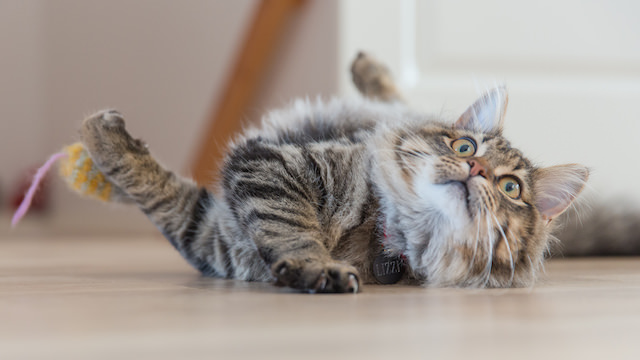Claw marking is a standard behavior for most feline species. The act of scratching is an instinct to cats. As people who want to live happily with cats, we must try to channel (and can never truly hope to eliminate) this behavior. Cat owners believe that cats scratch to sharpen their claws, but really it is much more than that. Even cats with no claws at all will still go through the scratching motions. Has science found a way to use what comes naturally to cats to help them fit better into a human world? Maybe so.
Experts feel that scratching behavior maintains claw health but is also a form of visual and pheromonal (hormone) marking. Cats produce a marking chemical between their toes (interdigital semiochemical) that they can release when they scratch. This may act as a sign or signal to other cats or animals of things like territory boundaries.
For years, the veterinary industry has been trying to find ways to utilize what we are learning about cats (and their toes) to help channel this behavior since owners hate having their furniture destroyed. If the chemical is released when cats flex their toes and it marks, could we surmise that placing the chemical on an object deemed appropriate by a human (like a scratching post) would also encourage the cat to choose the post?
A recent study looked into this idea and actually proved that use of a synthetic semiochemical on scratching posts seemed to induce the cats to choose it over other untreated posts that were alike in every other way. 1
This is really promising news for cat lovers. If we can influence our cats’ choices to direct them toward appropriate targets, it will improve all of our lives. While we wait for the commercially available product, offer your cat pleasing options to scratch and try different ones to find his preference. Make sure you have a vertical surface that is covered with a rough material. Cats love to hook their claws in so they can stretch their front legs. Stretching seems most common when waking, so make sure you place the desirable objects near resting places. Distract your cat whenever she scratches something that you do not want her to do and redirect her mind elsewhere.
Do you love cats? So do I! Find me on Facebook to join the conFURsation by clicking here.
- Induction of scratching behaviour in cats: efficacy of synthetic feline interdigital semiochemical. J Feline Med Surg. 2013 Oct;15(10):872-8. doi: 10.1177/1098612X13479114. Epub 2013 Feb 21.Cozzi A, Lecuelle CL, Monneret P, Articlaux F, Bougrat L, Mengoli M, Pageat P.

